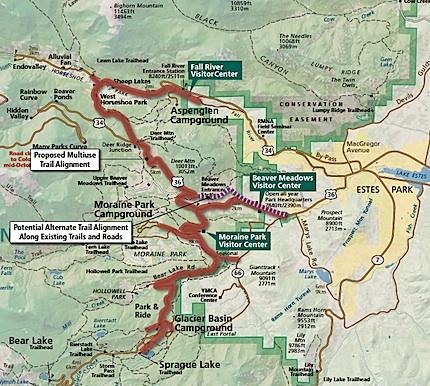Rocky Mountain National Park officials are considering the creation of a 15.5-mile-long trail for use by hikers and cyclists that would run from the Fall River Entrance to Sprague Lake, passing the Aspenglen, Moraine Park, and Glacier Basin campgrounds along the way.
A 2009 feasibility study identified potential trails that would generally follow the existing park roads. As currently envisioned, the trail might be attached to existing roads, might be separated slightly, or may extend away from the road. The idea is to create a pathway similiar to one in Grand Teton National Park that parallels the Teton Park Road.
"It would be along existing road corridors in the park. There would be very limited locations where it might not be along a road corridor," explained Larry Gamble, chief of planning and compliance at Rocky Mountain. "It’s so early in the planning process we don’t know exactly where it would be, we don’t know what the surface materials would be, we can tell you that 'multi-use' in our parlance would be self-propelled. So it would be entirely non-motoried. It could include bikes, it could include someone with a stroller, people on foot that sort of thing.”
Bikes in the national park currently are restricted to paved and unpaved roads only, not trails. Park officials see this proposal as one way to expand access to Rocky Mountain. As described in park documents, the trail would not only connect with campgrounds inside the park, but also tie into multi-use trails managed by the Town of Estes Park and the Estes Valley Recreation and Park District.
“In the Estes Valley a very robust trail system is evolving even as we speak, and they have plans for getting the trail out to our Fall River Entrance, so I think the broad vision, and we're talking years in the future, the broad vision would be to link this all up with what’s happening outside the park," said Chief Gamble.
The proposal is so new that many questions remain to be answered, and park staff is hoping the public can provide input as to any questions they might have overlooked. For now, if the project is approved to move forward, it's undecided how foot and wheeled traffic would be managed for public safety, whether horses would be permitted on the trail, whether it would be open in winter for snowshoers and cross-country skiers, whether it would be paved, or have a crushed cinder type of surface.
What is known, is that it would not be a cheap project to complete, and could take years to complete, with various segments phased in as money becomes available.
"We’re talking millions of dollars if this is approved," the chief said. "We’d have to seek funding in the millions of dollars to build this if we would do the whole thing.”
Public comment on what issues the park staff should consider in developing an environmental assessment around the proposal currently is being accepted, with a public meeting scheduled for February 19 at the Estes Valley Public Library in Estes Park from 4:45 p.m. until 6:15 p.m.
Possible issues that might merit consideration include impacts on vegetation and wildlife, whether the park can afford the cost of installing the trail as well as maintaining it down through the years, would such a trail lead to demands for similar trails elsewhere in the park, would dogs be allowed on it, would it be groomed in winter for cross-country skiing, and would it set a precedent for allowing mountain bikes on other trails both in Rocky Mountain and elsewhere in the National Park System?




Comments
Oh my Lord. Would the trail create a precedent to allow mountain bikes in the NPS? Man, those guys are stuck in the early 80s...
I oppose the multi-use trail. There are so many places people can ride their bicycles but there are very few places where hikers can walk without being in danger of being run-over by bicycles. There are many other objections as well which you have already listed in your proposal. The millions of dollars this would cost could be used to much better effect elsewhere.